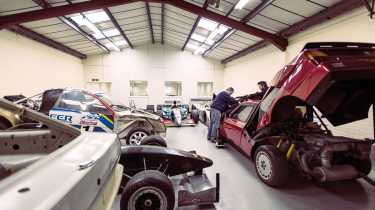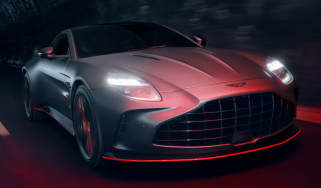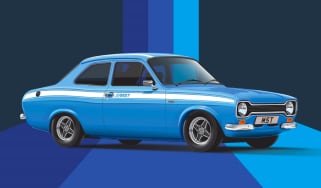Geoff Page Racing: inside the workshop
From Group B motors to turbo F1 engines, Geoff Page has worked on them all – and got them running better than ever. We take a look inside his workshop
‘I’m usually the last to leave, and sometimes I look back just before I switch the last light off and I think, “How did I end up looking after all this?” It’s crazy, really.’
Standing in the doorway now, looking down the length of the small workshop, I can see exactly what Geoff Page means. It’s like an Aladdin’s cave of ’80s exotica. ‘People always ask how I got into this,’ says Geoff as he leans on a workbench, ‘and I have to explain that cars and motorsport are all I’ve ever known.’ His story bears this out. When he was young he had a very successful stint in karts. In his first year he beat Johnny Herbert to the Lincs Kart Club title and he remains the youngest person to ever have raced in the Short Circuit 125cc World Cup at Morecambe (he was just 16). By the end of 1984 he had four offers of works drives in Formula Ford, including one from Van Diemen. ‘The trouble was, although they were works drives you still had to bring money,’ says Geoff. ‘A lot of money.’
By this time his parents had moved down to Essex, where Geoff started working for Jaguar specialist Alan Collins, building and maintaining C-, D- and E-types. That was during the daytime. When he finished at 6pm he would wander over the road and do an evening shift in Terry Hoyle’s workshop, where they would regularly have twenty Group 4 Escort engines lined up. Eventually Geoff went to work for Hoyle full-time and it was there that he became fully immersed in Group B engines. Hoyle not only ran the engine programme for the Ford RS200, but also fettled Audi Quattro A1 and A2 engines for the Audi Sport UK team and Metro 6R4 motors for Austin Rover.
It was while he was working for Hoyle that the Formula Ford deals were on the table, but he’ll never know where a career in single-seaters might have taken him, because after seeing an advert placed by the Tyrrell team, Geoff decided to follow his dream of becoming a Formula 1 mechanic. He beat 156 other applicants for one of three places on the Tyrrell F1 team and spent 1985 working on the first turbocharged Tyrrell – the 014 driven by Martin Brundle and Stefan Bellof (and then Philippe Streiff after Bellof died racing a Porsche 956 at Spa).
Geoff speaks fondly of Tyrrell and the family atmosphere there (he tells me about the factory gatherings after each GP weekend, with a cake baked by Don the janitor), but at the end of the season he returned to Terry Hoyle, where he continued working on the RS200 engine and, amongst other things, built the first-ever RS500 engine. From Hoyle’s, Geoff moved on to work for David Mountain of Mountune, where he looked after part of their WRC customer engine programme. He then set up East Coast Racing, which saw him running the RS200 IMSA programme.
A spell with Janspeed building cars for the BTCC was followed by another two years in F1, first with Pacific Grand Prix it 1995, then working for Brian Hart running the 830 Series 3-litre V8s in the back of the Arrows cars in 1996. After this he returned to building WRC engines for David Mountain, before setting up Geoff Page Racing in 2007, specialising in rebuilding and restoring high-end race machinery – just two doors down from where he used to work for Terry Hoyle!
It’s an extraordinary CV by any standards and Geoff’s phone book reads like a Who’s Who of the race engineering world, all the way up to people like Ross Brawn, who is a friend on the internet. But it’s the metal in his workshop that we’re interested in today, so Geoff gives us a tour, starting with the Audi Sport Quattro S1. ‘It was used as a test car so everyone has driven it. Rörhl, obviously, but also Stig, Michèle and Hannu. The owner very kindly let me have a go too,’ says Geoff, grinning like a schoolboy. ‘I had it on one wheel – left rear I think it must have been – coming out of a corner and it was still driving forwards! Amazing machine. You see the button on the gearstick? Well, it’s a six-speed synchro ’box, so you can’t crash it through, but push that button and it will automatically dip the clutch as you change gear. It momentarily takes drive off the power-steering pump and puts 2000psi through the pedal – it would take your foot off if you left it under there. This car also has a groundbreaking mechanical system of what we would now call anti-lag.’
I’m allowed to sit in the car – the door is incredibly light (just like the aluminium roll-cage…) and I love the makeshift box jutting out so that you can brace your knee effectively, presumably added for Rörhl’s gangly limbs. It feels like a monster even resting quietly inside the workshop.
We walk past a Dax Rush and an RS500 and into the room next door, where I instantly become engrossed in looking at Ari Vatanen’s Pikes Peak Peugeot 405. Most of the iconic Pioneer-liveried bodywork with those humungous wings is elsewhere at the moment but it affords us a rare view of what’s under the skin. It’s astonishing to see how far to the right the turbocharged four-cylinder ‘T16’ engine sits. Look inside, and between the gearstick and the driver’s seat is a black metal pole running fore and aft. Curious. Then you realise it’s a shaft running to the rear steering box – the 405 T16 has four-wheel steering.
Geoff has looked after this car for a number of years, but he’s also been closely involved with another Pikes Peak car – an RS200 project, once driven by Stig Blomqvist, now by Mark Rennison. It appeared in evo back in 2004 (issue 072), when with 900bhp it ran a 0-60mph time of 3.46sec, and 0-120 in 7.51sec – 1.7sec quicker than a McLaren F1. Geoff is now in the process of reverse-engineering an aluminium-block version of the YB engine to be reliable at 1000bhp…
Beyond the Peugeot is a car so rare that even Geoff had never seen one before it recently rolled into his workshop – a road-going Lancia Delta S4. It is an ugly thing really – bulbous of bum and thin of snout, but when you lift up the rear clamshell (that’s everything behind the B-pillar and it’s surprisingly heavy given that it’s glassfibre) you can’t help but be in awe as you see the twin dampers each side. The bespoke Pirelli P Zero tyres are extraordinary too, appearing to have no tread on the outside shoulders, like the cambers have been all wrong and they’ve worn unevenly.
Nose-to-nose with the Lancia is the 1991 Sauber Mercedes C291, which was the last sportscar that Schumacher drove before he moved to F1. The C291 is the car that replaced the C11 after the FIA did away with Group C regulations for the 1991 season, and as a result this has a 3.5-litre naturally aspirated flat-12 in it. It is, in my opinion, the most beautiful car of that era, and the delicate, wafer-thin, carbon bucket seat inside is a thing of wonder.
While I’ve been drooling over the C291, Geoff has been busy with one of the two Arrows A9s in the other corner. He’s been attaching the exhaust manifold, complete with a huge snail of a KKK turbo, to the mighty Megatron engine so that I can see it in all its glory. They say the 1500cc, four-cylinder BMW M12 (or Megatron as it was rebadged later) is the most powerful F1 engine ever, but Geoff isn’t convinced by the figures. ‘I’ve done quite a few Megatrons and I have my doubts that they actually hold together at the 1500bhp they said they used to make,’ he says. ‘Who am I to call anyone a liar, but having seen how they are mechanically inside, I can’t see that the crank and block could handle that sort of power. I can see it taking 1200bhp, but 1500bhp…? The block is only cast iron – effectively a standard 2002 off-the-shelf item. They did weather them [to reduce the stresses and lessen the risk of cracking] and there’s lots of stories about the guys at BMW Motorsport leaving them out the back of the factory to get rained on. They used to go out and have a piss on them, they say! But as for them making 1500bhp and staying in one piece, I don’t know… If they did run anywhere over 1200bhp, no wonder they used to blow up!’
The Megatron and its like can be far more reliable today, however. ‘Ten years ago people would shy away from turbo F1 engines, saying, “Ah, you don’t want to run those, they blow up.” But that’s not true,’ says Geoff. ‘We use a Life ECU on the cars, with a mixture of modern and old sensors, to try to keep everything looking as authentic and old-fashioned as possible, and they now produce more power from less boost than they ever did back in period. This Arrows A9, hot or cold, put the starter in the back, press the button and it’ll start just like that. No need to touch the throttle. One person could run that car. Drive it down the pitlane like a shopping car and it’ll go from 100bhp to 750bhp, quick as you like. And it’s reliable.’
He continues: ‘Take the Hart 415T engine, which is a low-compression engine. We run that with high-octane fuel, lots and lots of spark advance, 3.3bar of boost and it makes 830bhp reliably. And I’ve seen that many, many times. Back in the day – and I worked for Hart in ’96 – I believe that in truth they never had an 800bhp engine come out of the factory. So that’s pretty bloody good bearing in mind that they had the so-called rocket fuel with 150 octane, although it was actually more of a chemical fuel than a gasoline and had a high percentage of toluene, which we don’t use today.’ He now uses a VP 117- or 118-octane oxygenated dragster fuel.
‘We run most of the F1 stuff at between 700 and 800bhp, which is enough to make them exciting with only 520 or 530kg,’ says Geoff. ‘We run a Beatrice Lola with a Hart 415T engine and it was doing 173mph into Paddock Hill Bend and 165mph up to Druids. And they make the right authentic noise too, which is very important – you have to have the right noise.’
This gets to the heart of Geoff Page. He knows and loves engines, talking with not only a deep knowledge, but a real passion. While I look at cars and imagine what they are like to drive, Geoff seems to care, first and foremost, about how they run. He talks most excitedly when he’s by the workbenches with all the engines lined up. As well as the aluminium YB engine, in the last four years he’s reverse-engineered a subtly improved 6R4 engine, and he’s currently developing an engine called a Musset MR-1500, which is a 1.5-litre turbocharged motor, based on an in-line four-cylinder Suzuki Hayabusa unit. Geoff says it will put out over 750bhp in full ‘EVO 2’ spec. He also looks after the only running V6 Cosworth GBA engine in the world (from an ’86 Lola). He talks about them like they’re his children.
As we return to the main workshop he goes back to the Audi, gets in and starts it up, warming it lovingly for a few minutes before getting out and standing next to me while it idles. ‘Lovely, isn’t it?’ he says, smiling broadly. ‘Smooth as anything.’




